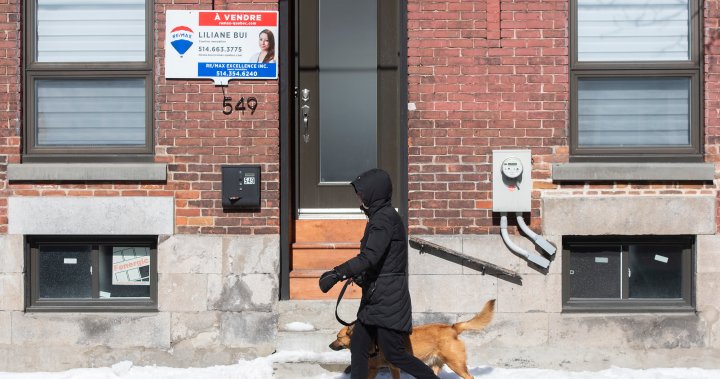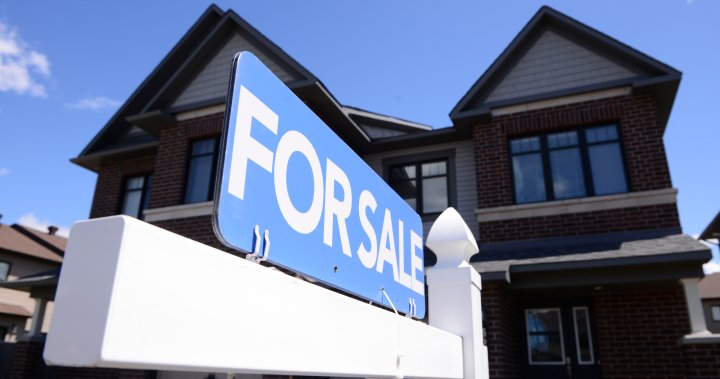After nearly two years of hikes to the Bank of Canada’s benchmark interest rate, some forecasters are expecting the housing market correction will come to an end in 2024.
But when that bottom hits, and how fiercely home sales and prices rebound, is a question dogging some Canadians who continue to grip the sidelines of the market.
The central bank’s policy rate could act as a barometer for the Canadian housing market in 2024, with forecasts for interest rate cuts potentially lifting some of the pressure off of would-be buyers next year.
Despite three consecutive holds from the Bank of Canada in its latest decisions, Ipsos polling conducted exclusively for Global News shows that many Canadians are feeling trapped by the rapid run-up in interest rates over the past two years.
Of the more than 1,000 Canadian adults surveyed by Ipsos from Dec. 8-11, some 73 per cent said high rates are keeping them on the outskirts of the housing market, and they won’t buy or sell as a result.
Elevated interest rates are particularly sidelining millennials (85 per cent), as well as those in British Columbia (76 per cent) and Quebec (86 per cent), according to Ipsos.
Ipsos Global CEO Darrell Bricker tells Global News that while higher borrowing costs might be a barrier for many getting into the housing market next year, elevated interest rates could give some sellers a push if they’re unable to handle increased mortgage payments at renewal.
“I think the number one issue that we’re going to have to look at in terms of housing going forward is whether or not people who currently have mortgages are able to afford them,” he says.
RBC assistant chief economist Robert Hogue tells Global News that he expects activity to pick up ahead of the traditionally busier spring market, but high borrowing costs will continue to subdue homebuying in the first half of 2024.
A decline in fixed mortgage rates tied to softening bond yields might incentivize some buyers to jump into the spring market, he says, namely investors who are looking to time the price trough.
Hogue sees supply in the housing market continuing to grow in the early days of 2024, but doesn’t anticipate that sellers are going to list en masse under the weight of higher mortgage rates at renewal.
Though a fresh crop of Canadian homeowners’ mortgage terms are set to expire in the new year, Hogue says RBC isn’t expecting many will be forced to sell. He does see many households needing to rein in spending amid higher rates at renewal, but he argues the mortgage stress test should have provided the necessary buffer for defaults or forced sales.
“This is a dynamic that’s already been in place for a few months now, but we don’t expect that to turn into a massive wave of sellers that would tip the market into some kind of a spiral downwards where you’ve got a significant imbalance with no buyers and lots of sellers and that driving prices down,” Hogue says.
When and if interest rate cuts do finally materialize — big bank forecasts are penciling in the second quarter of the year — Hogue sees a modest uptick in demand following.
But he says buyers won’t come back in droves until there’s been meaningful improvement in the cost of borrowing — namely, multiple interest rate cuts. For that reason, Hogue sees housing market activity getting a “lift up” in the second half of the year.
The forecast is similar from Royal LePage, which projected a pick-up in sales and prices in the second half of 2024.
Get the latest Money 123 news.
Sent to your email, every week.
The national brokerage said in its 2024 outlook that it expects the aggregate price of a home in Canada to rise 5.5 per cent year-over-year in the fourth quarter. If these predictions hold, home prices would near their pandemic peaks seen in the first quarter of 2022.
Royal LePage CEO Phil Soper says that there’s pent-up demand in the housing market, and Canadians are looking for confidence that the price correction is over before they come off the sidelines.
When interest rates start to fall, he predicts that will be enough to convince Canadians that the home they buy today won’t be worth less tomorrow, clearing a path to get back into the housing market.
“Whenever it happens and however small, even a 25-basis-point decline in the Bank rate will have an outsized impact on Canadian housing activity,” Soper says.
The Bank of Canada itself has signalled that it’s wary of cutting rates too quickly because of the impact it could have on the housing market. Deliberations from the Dec. 6 rate hold showed governing council worried about a premature move to cutting rates spurring a “rebound” in housing activity that could fuel shelter price inflation.
As much stress as homeowners have had to bear when they renew in Canada’s higher rate environment, those outside the ownership market have also been subject to spikes in rent over the past year.
Even as overall inflation — now sitting at 3.1. per cent — has fallen sharply from its 8.1-per cent peak in June 2022, shelter remains a significant source of higher costs in Canadians’ lives.
There were signs that the pace of increases was slowing towards the end of 2023 according to a recent report from Rentals.ca and Urbanation. It noted national rent prices were still rising 8.4 per cent annually in November, but the pace cooled from October. And that average rents were flat or falling slightly in Vancouver and Toronto.
An eventual easing in borrowing costs could help to not only spur activity in the ownership market, but also relieve some of the pressure that’s been building on the rental side of the equation as more renters buy and their vacated units come back on the market, Hogue says.
“Once ownership affordability is going to improve to a certain extent, then just this natural flow up the housing ladder is going to reassert itself to a certain degree and that should bring a little bit of relief on the rental side,” he says.
Canada’s rental market has faced pressure from a number of fronts in recent years: a surge in demand from newcomers who tend to rent before they buy; a lack of adequate housing supply particularly in major cities; and higher borrowing costs putting a cap on how many households can afford to leave their apartment behind for home ownership.
Hogue warns that there will still be “a lot of tension” in the rental market despite hope for relief in 2024. Immigration levels are projected to ease mildly over this past year’s record levels but still “stay strong,” he says, putting a floor on demand levels.
Renters’ inability to break into the ownership market should be worrying for policymakers, says Bricker.
The Ipsos polling shows that 77 per cent of those surveyed now believe home ownership is only for the rich, while 71 per cent have given up on ever owning their own home.
Housing affordability hit its worst levels in 41 years in the third quarter of 2023, according to a Bank of Canada index, as rising borrowing costs coincided with an uptick in home prices.
That trend has shown signs of reversing in the final quarter of the year, however, with many markets seeing prices drop as fixed mortgage rates on offer started to decline in anticipation of rate cuts in 2024.
Comparator site Ratehub.ca noted that the income needed to buy a home declined monthly in November across the 10 major cities it tracks, with one notable exception: Calgary.
Soper says that Calgary, and Alberta more widely, have been a “standout of affordability” in recent years with relatively accessible home prices and a strong economy. That’s helped to drive a boom in population in Alberta, both from newcomers and existing Canadian residents seeking an affordable place to call home.
“I believe we have crossed a point where employment is (no longer) the driving factor between inter-city or interprovincial migration, and it’s now become the cost of housing made possible by both the high variances in the value of homes, but also the technology behind virtual work,” Soper says.
Nationally, Hogue says he expects affordability levels will continue to “restrain” first-time homebuyers in particular, until there are multiple rate cuts from the central bank to lower the barrier to qualify for a mortgage.
Another factor impacting housing affordability is lack of supply.
While housing starts largely held up under the weight of higher rates in 2023, Hogue says the pace has not been in line with what Canada needs to restore affordability in the market.
The Canada Mortgage and Housing Corp. has said the country will need to add an additional 3.5 million housing units by 2030 on top of the current pace of building to make housing affordable again for new and existing Canadians.
Hogue will be watching construction activity on purpose-built rental apartments closely in the new year, with the market in “desperate need” of new rental units.
The federal government recently announced a plan to reignite a wartime building effort to ramp up the pace of home construction in Canada. Ottawa has leaned on programs new and old in the past few months to lower the barriers to getting shovels in the ground and turned on the funding taps for provinces and municipalities to incentivize densification and faster project approvals.
However, Soper says that with a need for immigration to sustain the Canadian economy, there’s little hope that a rapid building effort alone can keep up with the influx of demand and restore affordability.
“Efforts by all levels of government to address our housing supply crisis are most welcome,” he says.
“I don’t believe they have any hope of making housing more affordable in absolute terms — in other words, reducing the value of homes in the country.”
Bricker says that with politicians at all levels of government making a flurry of promises and proposals about housing affordability in recent months, 2024 could be a make-or-break year for Canadians who are hungry for results.
“Over the course of 12 months, we’re going to see whether or not they’re actually going to be able to make any success with that,” he says.
“People are not going to wait for a long time to see whether or not they’re actually succeeding.”
— with files from Global News’ Anne Gaviola




